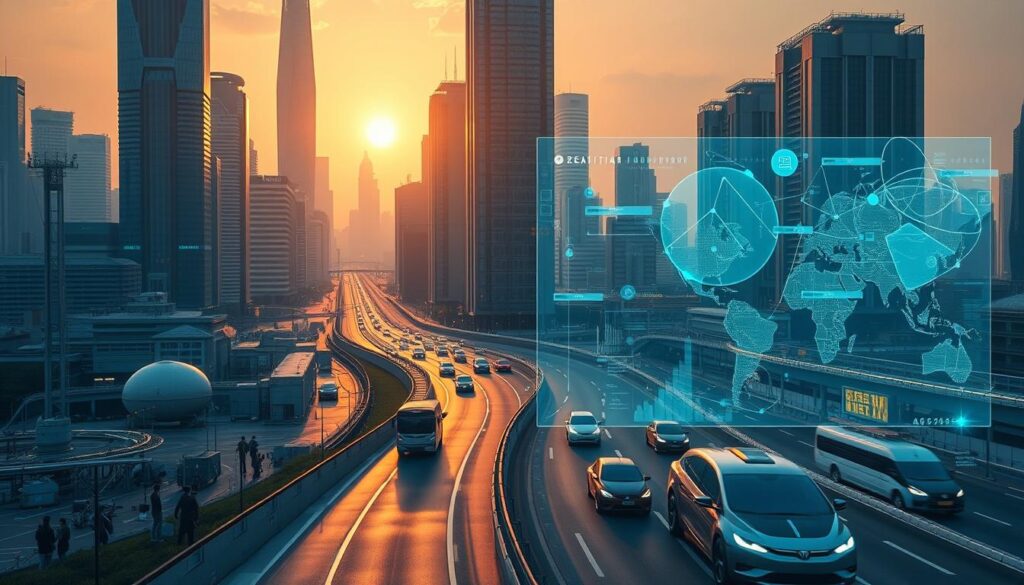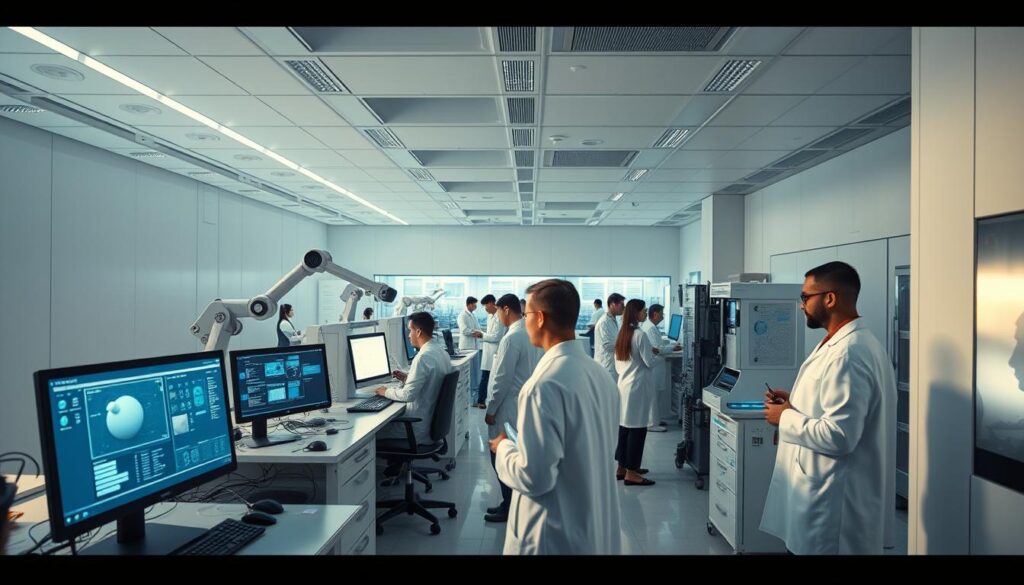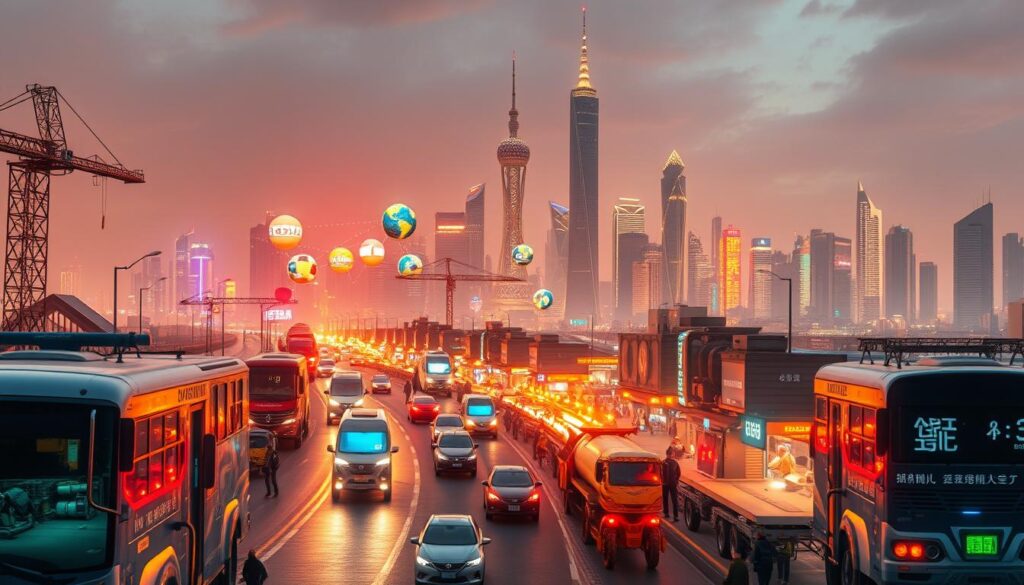“The future belongs to those who believe in the beauty of their dreams,” said Eleanor Roosevelt. This sentiment resonates deeply in the world of artificial intelligence, where dreams of innovation are becoming reality at an unprecedented pace.
Artificial intelligence has transformed industries, driven by breakthroughs in research and cutting-edge models. The global race to dominate this space has seen remarkable strides, particularly in regions investing heavily in tech advancements. From startups to state-backed initiatives, the focus on innovation is reshaping the future.
China’s rapid rise in this field is noteworthy. With over 4,300 AI companies and a core industry value reaching RMB 508 billion in 2022, the ecosystem is thriving1. DeepSeek, a rising star, trained its AI model using just 2,000 specialized chips, a fraction of what Western counterparts require2. This efficiency highlights the potential of resourceful innovation.
As we delve deeper, it’s clear that the intersection of research, models, and technology is driving this transformation. The journey ahead promises even greater advancements, shaping a future where artificial intelligence plays a pivotal role.
Key Takeaways
- Artificial intelligence is revolutionizing industries globally.
- Innovation and research are key drivers of AI advancements.
- Efficient models are enabling rapid progress in the field.
- China’s AI ecosystem is robust, with thousands of companies.
- Resourceful approaches are reducing costs and increasing efficiency.
Introduction to China’s AI Revolution

The global race for artificial intelligence dominance has reshaped industries and economies. Nations are investing heavily in technology to secure their positions on the world stage. Among them, China has emerged as a formidable player, driven by ambitious goals and strategic policies.
Understanding the Global Impact
China’s rapid advancements in artificial intelligence are influencing global markets. With over 4,500 AI companies, the country represents 15% of the world’s total3. This growth is supported by significant investments, reaching an estimated $85.65 billion in 20234.
The impact extends beyond borders. China’s AI ecosystem is closing the performance gap with U.S. models, as seen in benchmarks like SuperCLUE5. This progress underscores the country’s growing influence in the world of technology.
Overview of China’s Technological Ambitions
China’s goal is to become a global leader in AI by 2030. Government policies and state-backed initiatives are fueling this ambition. For instance, the core AI industry’s value reached RMB 508 billion in 2022, marking an 18% year-on-year growth3.
Key indicators highlight this progress:
- Over 1,100 core AI companies in Shanghai alone3.
- More than 100,000 professionals working in the sector3.
- Strategic investments in domestic AI chips and infrastructure5.
These efforts are part of a broader vision to integrate AI into sectors like finance, healthcare, and autonomous systems. The country’s focus on innovation and research is setting the stage for long-term leadership in the field.
Historical Context and Research Methodology

From imitation to innovation, China’s AI sector has charted a unique path of growth. Over the past two decades, the country has transformed from a follower to a leader in artificial intelligence. This evolution is rooted in strategic policies, robust research, and a focus on original technology advancements.
Evolution of AI in China
China’s AI journey began with a focus on adopting Western models. However, the industry quickly shifted toward developing homegrown solutions. Beijing, for instance, has been the most productive city for AI research since 20026. This shift reflects a broader trend of self-reliance and innovation.
Significant milestones include the launch of the “China Computing Net – Smart Computing Network” in 20227. This initiative marked a pivotal step in building a national computing power network. Such efforts have positioned China as a global hub for AI development.
Approaches to Innovation Measurement
Measuring innovation in China’s AI sector involves comprehensive methodologies. Over two million AI papers, published between 1990 and 2019, have been analyzed to track progress6. These datum highlight the country’s growing influence in global research.
Another key approach is the analysis of patent filings. The Chinese government’s focus on computing infrastructure, including GPUs, has driven technological advancements7. This systematic evaluation ensures that progress is both measurable and impactful.
For more insights into China’s AI advancements, explore how AI is transforming transportation in the region.
China’s Thriving AI Industry and Market Dynamics

The rapid expansion of artificial intelligence is reshaping global markets and industries. This transformation is particularly evident in the thriving AI sector, where innovation and investment are driving unprecedented growth. The interplay between market forces and technological advancements is creating a dynamic ecosystem.
Trends in Market Growth and Investment
The AI industry is experiencing a surge in investment, with significant capital flowing into research and development. In 2020, the country led in global production across seven out of ten advanced industries, showcasing its dominance8. This growth is fueled by both private companies and state-backed initiatives.
Key sectors like IT, Computers, and Electronics are witnessing remarkable progress. For instance, the Computers and Electronics sector achieved a 26.8% global market share, closely trailing the U.S8.. Such advancements highlight the competitive edge of the region’s AI ecosystem.
Comparative Analysis with Global Peers
When compared to global peers, the AI industry stands out for its rapid growth and innovation. For example, in the Chemicals sector, the region achieved a 29.1% market share, surpassing the U.S8.. This performance underscores the region’s ability to leverage technology for economic gains.
The table below provides a comparative overview of key sectors:
| Sector | Market Share (Region) | Market Share (U.S.) |
|---|---|---|
| IT and Information Services | 25.3% | 36.4% |
| Computers and Electronics | 26.8% | 36.4% |
| Chemicals | 29.1% | 28.4% |
| Machinery and Equipment | 32.0% | 29.1% |
These datum reflect the region’s growing influence in the global AI landscape. The focus on innovation and product development is setting new benchmarks for competitors worldwide.
As the AI industry continues to evolve, the role of companies in driving innovation remains critical. The interplay between market dynamics and technological advancements will shape the future of this transformative field.
Government Support in Advancing AI Innovation

Strategic government initiatives are driving unprecedented advancements in artificial intelligence. By providing financial aid and policy measures, the state plays a pivotal role in fostering innovation and accelerating technology development. This support is not just limited to funding but also includes strategic planning and resource allocation.
State-Directed Funds and Subsidies
State-directed funds are a cornerstone of AI growth. These funds target underrepresented regions, ensuring balanced development across the country. For instance, the Shanghai City Xuhui Government Services Large Model launched in June 2024 aims to enhance efficiency through AI9.
Subsidies are another critical tool. Domestic AI companies benefit from financial incentives, enabling them to invest in research and model development. Baidu’s Qianfan platform, for example, reduces training costs by up to 90% compared to in-house development9.
Impact on Regional and Sectorial Growth
Government backing has significantly boosted regional and sectorial growth. In 2024, the country hosted over 4,500 AI companies, accounting for 15% of the global total9. This growth is supported by policies like the “Interim Measures for the Management of Generative Artificial Intelligence Services,” which guide AI development and governance9.
Key outcomes include:
- Enhanced industry capabilities in sectors like healthcare and autonomous systems.
- Increased investment in domestic AI chips and infrastructure.
- A thriving ecosystem for rapid technology advancement.
These measures underscore the government‘s commitment to establishing a robust AI ecosystem, setting the stage for long-term leadership in the field.
Breakthroughs by Top Chinese AI Start-Ups

Innovative breakthroughs by Chinese AI start-ups are setting new benchmarks in the global tech landscape. These firms are driving rapid advancements in artificial intelligence, leveraging cutting-edge models and robust research to redefine the industry.
The Role of Academic Institutions
Academic institutions like Tsinghua University play a pivotal role in incubating AI talent and fostering innovation. These institutions collaborate with companies to bridge the gap between theoretical research and practical applications10.
For instance, Zhejiang University has been a significant beneficiary of the National Key Technologies R&D Programs, receiving $3 billion in grants11. This synergy between academia and industry accelerates development and ensures a steady pipeline of skilled professionals.
Case Studies: Zhipu AI, Moonshot AI, and More
Zhipu AI and Moonshot AI are prime examples of domestic firms pushing the boundaries of AI. Zhipu AI’s R1 model has been adopted by major tech giants like Tencent and Alibaba, showcasing its versatility and efficiency10.
Moonshot AI, on the other hand, has focused on creating multi-modular interfaces that integrate various services, offering a more comprehensive user experience compared to Western tools12. These companies are not only enhancing model performance but also reducing costs significantly.
The table below highlights key achievements of these start-ups:
| Company | Key Achievement | Impact |
|---|---|---|
| Zhipu AI | Adopted by Tencent, Alibaba | Enhanced efficiency in coding and reasoning tasks10 |
| Moonshot AI | Multi-modular interfaces | Improved user experience across platforms12 |
| DeepSeek | Secured 10,000 A100 GPUs | Boosted computing power for development11 |
These datum underscore the transformative impact of Chinese AI start-ups on the global industry. By combining academic expertise with entrepreneurial spirit, these firms are shaping the future of artificial intelligence.
How is China Leading in AI Technology?

Benchmarking AI models reveals fascinating insights into global technological progress. Recent studies, such as SuperCLUE, highlight how domestic models are rapidly closing the gap with their U.S. counterparts. These performance metrics underscore the growing competitiveness of the country’s AI ecosystem.
Performance Benchmarks Compared to U.S. Models
Chinese AI models are achieving remarkable results in benchmark tests. For instance, DeepSeek’s model rivals OpenAI’s GPT-4o in performance while being 90-95% more affordable13. This efficiency demonstrates the potential of resourceful innovation in the face of export restrictions.
Experts point to several factors driving this progress. Open-source platforms like Hugging Face showcase the popularity of Chinese models, with Alibaba’s Qwen leading in downloads14. These platforms allow developers to modify and build applications, fostering a collaborative environment.
“The rise of open-source Chinese AI contributions is reshaping the global landscape,” notes an industry expert. “Their strong performance and low cost to serve are setting new standards.”
The table below compares key performance metrics between Chinese and U.S. models:
| Model | Performance Score | Cost Efficiency |
|---|---|---|
| DeepSeek | 95 | 90-95% cheaper |
| OpenAI GPT-4o | 97 | High |
| Qwen (Alibaba) | 94 | Moderate |
These advancements are not just about performance. They reflect a broader strategy to reduce dependency on foreign technology. Domestic companies like Huawei and Baidu are investing in semiconductor design, creating viable alternatives to Nvidia’s GPUs14.
As the AI landscape evolves, these performance indicators will play a crucial role in shaping global competitiveness. The country’s rapid catch-up is a testament to its focus on innovation and strategic planning.
Advancements in Large Language Models and Open-Source Innovation

The evolution of large language models is reshaping the landscape of artificial intelligence. These models are not only enhancing performance but also democratizing access to cutting-edge technology. Open-source platforms are playing a pivotal role in this transformation, fostering collaboration and innovation.
Evaluating Model Performance on SuperCLUE
Recent benchmarks like SuperCLUE highlight the competitive positioning of domestic models. Alibaba’s Qwen 1.5, for instance, tied for second place with Claude in June 2024, showcasing its capabilities4. DeepSeek also entered the leaderboard, demonstrating significant progress in performance4.
These results underscore the efficiency of resourceful innovation. DeepSeek’s R1 model, for example, competes with OpenAI’s o1 model while being 90-95% more affordable14. This cost-effectiveness is a game-changer for companies seeking advanced solutions.
The Rise of Open-Source Platforms
Open-source platforms are democratizing AI research by providing free access to powerful tools. Hugging Face, a repository for large language models, hosts Alibaba’s Qwen, the most popular model on the platform14. This accessibility allows developers to modify and build applications, fostering a collaborative environment.
Chinese companies are leveraging these platforms to reduce dependency on foreign technology. For instance, Huawei, Baidu, and Alibaba are investing in domestic semiconductor design, creating viable alternatives to Nvidia’s GPUs14.
“The rise of open-source Chinese AI contributions is reshaping the global landscape,” notes an industry expert. “Their strong performance and low cost to serve are setting new standards.”
The table below compares key performance metrics between Chinese and U.S. models:
| Model | Performance Score | Cost Efficiency |
|---|---|---|
| DeepSeek | 95 | 90-95% cheaper |
| OpenAI GPT-4o | 97 | High |
| Qwen (Alibaba) | 94 | Moderate |
These advancements are not just about performance. They reflect a broader strategy to reduce dependency on foreign technology. Domestic companies like Huawei and Baidu are investing in semiconductor design, creating viable alternatives to Nvidia’s GPUs.
As the AI landscape evolves, these performance indicators will play a crucial role in shaping global competitiveness. The country’s rapid catch-up is a testament to its focus on innovation and strategic planning.
For more insights into the reasoning behind these advancements, explore why QWQ 32B preview is the.
Strategic Policies: Self-Reliance and Industrial Roadmap

Strategic policies are shaping the future of technological innovation globally. The focus on self-reliance is driving significant advancements in key industries, particularly in artificial intelligence. These efforts are backed by national priorities and robust government initiatives.
National Priorities for Technological Sovereignty
The country is investing heavily in infrastructure to consolidate its position as a global leader. By 2030, the core AI industry is projected to exceed $140 billion, with related sectors reaching $1.4 trillion15. This growth is supported by over 4,300 companies contributing to the ecosystem15.
Government-backed initiatives are accelerating the pace of research and development. For instance, the share of AI-influenced revenues in companies more than doubled from 2018 to 2021 and is expected to triple by 202415. These measures are part of a broader strategy to reduce dependency on foreign technology.
Key priorities include:
- Establishing over 50 new national and industry standards for AI by 202415.
- Developing over 20 international standards to support global collaboration15.
- Promoting research and development through targeted funding and subsidies.
Market-oriented policies are also driving innovation. Companies are benefiting from these policies, with 90% viewing generative AI as essential for growth15. The interplay between strategic exports and domestic development is bolstering the AI ecosystem.
The table below illustrates the roadmap for future industrial growth:
| Initiative | Target | Impact |
|---|---|---|
| Core AI Industry | $140 billion by 2030 | Strengthening technological sovereignty15 |
| Related Sectors | $1.4 trillion by 2030 | Expanding market influence15 |
| AI Standards | 50+ by 2024 | Enhancing global competitiveness15 |
Supporting datum highlights the growth trajectory. For example, the country accounted for 26% of the world’s total computing power as of June 202415. This focus on self-reliance and strategic planning is setting the stage for long-term leadership in the field.
Integrating AI into Healthcare and Autonomous Systems

The integration of artificial intelligence into healthcare and autonomous systems is revolutionizing industries worldwide. From medical diagnostics to electric vehicles, AI is driving innovation and efficiency. This transformation is reshaping the market and creating new opportunities for development.
Innovations in Medical Diagnostics and Drug Discovery
AI is transforming healthcare by enhancing diagnostics and accelerating drug discovery. Tools like MedGPT are streamlining patient care, reducing misdiagnosis rates, and improving clinical decision-making16. These applications are particularly impactful in regions with aging populations, where healthcare demands are rising17.
AI-powered platforms are also expediting research. By analyzing vast datasets, they identify potential therapeutic compounds faster than traditional methods16. This efficiency is crucial in addressing global health challenges.
Advances in Autonomous Vehicles and EV Technology
In the automotive sector, AI is driving advancements in autonomous vehicles and EV technology. Chinese automakers are leveraging AI to develop driverless cars and enhance electric vehicle performance. These innovations are setting new standards in the industry.
AI’s role in autonomous systems extends beyond vehicles. It is optimizing traffic management and improving safety features, making transportation smarter and more efficient17.
“AI is not just a tool; it’s a transformative force reshaping industries and improving lives,” says an industry expert.
The table below highlights key AI-driven advancements in healthcare and autonomous systems:
| Application | Impact |
|---|---|
| Medical Diagnostics | Reduced misdiagnosis rates, faster patient care16 |
| Drug Discovery | Accelerated research, faster therapeutic identification16 |
| Autonomous Vehicles | Enhanced safety, optimized traffic management17 |
These trends underscore the power of AI to drive innovation and improve outcomes. As AI continues to evolve, its applications will play a pivotal role in shaping the future of healthcare and transportation.
For more insights into AI’s transformative potential, explore how AI tools are revolutionizing industries.
Global Trade, Export Controls, and Tech Infrastructure

Global trade dynamics and export controls are reshaping the technological landscape, influencing innovation and infrastructure development. These factors play a critical role in determining access to advanced technologies and shaping the future of industries worldwide.
Regulatory Landscape and Export Controls
The regulatory environment governing global trade has become increasingly complex. Export restrictions, particularly from the U.S., aim to limit access to advanced technologies like high-performance chips. These controls are designed to maintain a competitive edge in the global market18.
Despite these measures, companies have adapted by leveraging alternative strategies. For instance, DeepSeek has built a robust infrastructure with 50,000 GPUs, including H100s and H800s, to ensure continued innovation19. This approach highlights the resilience of the sector in the face of external challenges.
Impact of U.S. Export Restrictions
U.S. export restrictions have significantly influenced access to advanced technologies. Chinese companies, for example, must use two to four times the computing power to achieve comparable results due to these limitations19. This has spurred investments in domestic alternatives and infrastructure upgrades.
By early 2024, large-scale H100 chip smuggling operations were reported, with transactions exceeding $100 million19. Such measures underscore the lengths to which companies are going to bypass restrictions and maintain progress.
Infrastructure Upgrades and Strategic Approaches
Infrastructure development has become a key focus for overcoming export controls. DeepSeek’s estimated GPU server capital expenditures amount to $1.63 billion, reflecting significant investment in tech infrastructure19. This investment ensures the availability of resources for continued innovation.
Additionally, the use of private clouds and local chip alternatives has emerged as a strategic approach. Huawei’s Ascend 910b chips, for example, offer a viable alternative to restricted imports, achieving up to 400 TeraFLOPS20.
The table below summarizes key data points on infrastructure and export controls:
| Metric | Value |
|---|---|
| DeepSeek GPU Infrastructure | 50,000 GPUs (H100s, H800s, H20s)19 |
| H100 Chip Smuggling Transactions | $100 million (early 2024)19 |
| Huawei Ascend 910b Performance | 280-400 TeraFLOPS20 |
These efforts demonstrate the sector’s ability to adapt and thrive despite external constraints. The focus on self-reliance and infrastructure development is setting the stage for long-term success in the global market.
Investments and Funding in China’s AI Sector

Investment in artificial intelligence is fueling unprecedented growth in technological innovation. Both private venture capital and state-backed funds are driving this expansion, creating a robust ecosystem for development and research.
Venture Capital Trends and Government Funding
Private venture capital is playing a significant role in the AI sector. Over 4,500 firms are currently developing and selling AI technologies, supported by substantial funding21. This influx of capital is enabling companies to innovate and scale rapidly.
Government funding is equally critical. Beijing plans to invest 10 trillion Chinese yuan (approximately $1.4 trillion) in AI and advanced technology over the next 15 years21. This commitment is driving the creation of new models and enhancing access to cutting-edge technologies.
The correlation between government funding and private sector investment is evident. For instance, Baidu’s generative AI and foundation models accounted for 656 million renminbi of its total 2023 fourth quarter revenue22. This synergy is accelerating economic and technological progress.
The table below highlights key investment trends in the AI sector:
| Source | Investment | Impact |
|---|---|---|
| Private Venture Capital | Supports 4,500+ firms21 | Drives innovation and scaling21 |
| Government Funding | 10 trillion yuan by 203821 | Enhances model development21 |
| Corporate Revenue | 656 million renminbi (Baidu Q4 2023)22 | Boosts economic growth22 |
These investments are shaping the future of the AI market. With over 50 companies developing large language models, the sector is poised for continued growth22. The focus on innovation and strategic funding is setting new benchmarks globally.
“The combination of private and public funding is creating a dynamic environment for AI innovation,” notes an industry expert.
As the AI sector evolves, these investments will play a crucial role in driving advancements and maintaining competitiveness on the global stage.
Overcoming Challenges and Navigating Market Consolidation
Navigating the complexities of global export controls and market pressures, companies are adapting to ensure long-term competitiveness. Regulatory hurdles and competitive obstacles are reshaping the landscape, requiring innovative strategies to thrive.
Regulatory and Competitive Obstacles
Global export restrictions, particularly on advanced technologies, have created significant challenges. For instance, U.S. controls on high-performance chips have forced companies to find alternative solutions23. These measures aim to limit access to critical resources, impacting development timelines.
Competition is also intensifying. With over 100 large language models (LLMs) competing in the region, companies must innovate to stand out23. This environment demands a proactive approach to overcome barriers and maintain a competitive edge.
Strategies for Future Competitiveness
To address these challenges, companies are adopting strategic approaches. One key strategy is investing in domestic alternatives. For example, Huawei’s Ascend 910b chips offer a viable solution to restricted imports, achieving up to 400 TeraFLOPS.
Market consolidation is another emerging trend. Firms are pooling resources to enhance efficiency and reduce costs. This partnership-driven model fosters innovation while addressing the need for improved controls and planning23.
Government policies also play a crucial role. The interim regulation on generative AI, effective since August 2023, provides a framework for compliance and innovation24. These measures ensure that companies remain competitive in a rapidly evolving market.
“The combination of strategic planning and resource pooling is essential for navigating today’s challenges,” notes an industry expert.
As the sector evolves, these strategies will be critical for sustaining growth and maintaining a leadership position in the global arena.
Future Trends: AI, Robotics, and Biotechnology
The convergence of robotics, biotechnology, and advanced manufacturing is shaping the future of industrial innovation. These fields are driving efficiency, expanding markets, and integrating data-driven insights into industrial processes. Companies that capitalize on these trends will maintain a competitive edge in the evolving tech landscape.
Emerging Priorities in Industrial Applications
Artificial intelligence is transforming industries by enabling smarter manufacturing processes. Robotics, combined with AI, is automating complex tasks, reducing costs, and improving precision. Biotechnology is revolutionizing healthcare and agriculture, offering sustainable solutions for global challenges25.
Data-driven insights are becoming central to decision-making. Companies are leveraging datum to optimize operations and predict market trends. This integration of technology and analytics is reshaping industries, from automotive to pharmaceuticals1.
The table below highlights key advancements in these fields:
| Field | Advancement | Impact |
|---|---|---|
| Robotics | Automation of complex tasks | Reduced costs, improved efficiency25 |
| Biotechnology | Gene editing and sustainable agriculture | Enhanced healthcare and food security25 |
| AI | Predictive analytics and machine learning | Optimized operations and market insights1 |
These trends are not just transforming industries but also creating new opportunities for growth. Companies that invest in innovation and research will lead the way in this dynamic environment. For more insights into how AI tools are driving these changes, explore our detailed analysis.
As the market evolves, the integration of AI, robotics, and biotechnology will continue to redefine industrial applications. This synergy promises a future where technology drives efficiency, sustainability, and growth.
Conclusion
The rapid evolution of artificial intelligence is reshaping global industries and economies. Strategic investments in research and innovation have reinforced the competitive edge of leading nations. Over the last five years, venture capital funding in the AI space has totaled approximately $290 billion in the U.S. compared to $120 billion in China26.
Performance benchmarks highlight the efficiency of domestic models, such as DeepSeek R1, which matches Western counterparts in both cost-effectiveness and capability27. This progress underscores the importance of collaborative approaches within the global tech ecosystem.
Looking ahead, the need for advanced development and ethical considerations will shape the industry in the coming year. As nations navigate challenges like data privacy and resource optimization, the world of artificial intelligence will continue to evolve, driving innovation and economic growth.
FAQ
What drives China’s advancements in AI technology?
How does China’s AI industry compare globally?
What role do Chinese start-ups play in AI development?
How does government policy shape China’s AI strategy?
What are the key applications of AI in China?
How do export controls affect China’s AI sector?
What are the future trends in China’s AI landscape?
Source Links
- China’s AI Revolution: The Global Tech Power Shift – The Geopolitics
- DeepSeek: How China’s ‘AI heroes’ overcame US curbs to stun Silicon Valley
- Exploring China’s Leading AI Hubs: A Regional Analysis
- How Innovative Is China in AI?
- China’s AI Revolution: How DeepSeek is Changing the Game
- The Beijing dilemma: Dependencies in global artificial intelligence research
- China’s AI development model in an era of technological deglobalization
- China Is Rapidly Becoming a Leading Innovator in Advanced Industries
- China And AI In 2025: What Global Executives Must Know To Stay Ahead
- China’s AI Breakthrough Signals a New Era of Tech Innovation
- Beyond DeepSeek: How China’s AI Ecosystem Fuels Breakthroughs
- How a top Chinese AI model overcame US sanctions
- China Upends the AI Race
- China wants to dominate in AI — and some of its models are already beating their U.S. rivals
- Artificial intelligence in the COVID-19 pandemic: balancing benefits and ethical challenges in China’s response – Humanities and Social Sciences Communications
- China Artificial Intelligence (AI) In Healthcare Market 2032
- What to Know About the New U.S. AI Diffusion Policy and Export Controls
- DeepSeek, Huawei, Export Controls, and the Future of the U.S.-China AI Race
- Why China Can’t Export AI Chips
- From chatbots to intelligent toys: How AI is booming in China
- China’s Generative AI Ecosystem in 2024: Rising Investment and Expectations
- China’s Domestic AI Competition Heats Up
- OXGS Report | Navigating geopolitics in AI governance > Oxford Global Society
- How AI is shaping industries in China | J.P. Morgan Research
- China Closing AI-Innovation Gap with the US
- China vs. U.S. in AI: Who’s Winning the AI Race?







